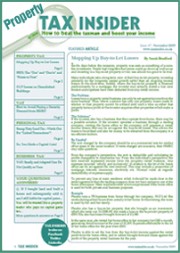Before you go, sign up to our free tax saving email course. Get 7 top property tax saving strategies in your email inbox that will help you save thousands in tax. Unsubscribe any time.
 A recent case heard by the Tax Tribunal (AJ Clarke v HMRC) has shed more light on what it takes to make a property your ’main residence‘ and thus exempt from capital gains tax (CGT). A recent case heard by the Tax Tribunal (AJ Clarke v HMRC) has shed more light on what it takes to make a property your ’main residence‘ and thus exempt from capital gains tax (CGT).
Mr Clarke lived with his wife and children at Oaks Farm. His marriage was failing and he wanted to get his children away from his wife’s influence. He bought 60 Nayland Road in July 2002 and moved in with his children. He had used a short term loan to buy it and needed to raise money to pay off the loan, so he obtained planning permission to build another property (58a) in the garden of No 60. He put No 60 on the market in December 2002, only 5 months after buying it, and it sold in March 2003. He moved in with his mother while 58a was completed, and was able to occupy it in July 2003.
In July 2005, he had to move back to Oaks Farm, as his (now divorced) wife had attempted suicide and he felt he had to be there. Number 58a was put on the market and sold in November 2005.
HMRC argued that neither of the Nayland Road properties had ever been his main residence and were thus not exempt from CGT. They pointed out that he had not notified anyone of his changes of address, and correspondence for him continued to be sent to him at Oaks Farm, where he had an office from which he ran his business.
They also argued that the use of the short term loan to buy No 60 indicated that he bought it with the intention of selling it and developing another property in the garden – which of course is what he had in fact done.
Although HMRC grudgingly accepted that Mr Clarke had in fact resided at both of the Nayland Road properties, they said that his residence in both of them was merely a temporary measure and not intended to be the start of a new ’permanent home‘ – an expression that does not appear in the legislation, but one HMRC are fond of using in these disputes.
Mr Clarke could have made life much easier for himself if he had written to HMRC within two years of moving into No 60, nominating it as his main residence, and then done the same again when he moved into No 58a, but he had not done so within the two year time limit, so the question of which property was his main residence had to be decided on the facts.
Normally, a married couple can only have one main residence between them. The case report does not make it clear, but I assume that HMRC accepted that they were permanently separated at the time Mr Clarke bought No 60, so that potentially Mr Clarke could have a main residence of his own.
If Mr Clarke had come to me for advice, I would probably have said he had a good case as far as No 58a was concerned, as he had lived there for a couple of years, but that HMRC would probably win the argument on No 60, given how he had financed the purchase and how quickly he had put it on the market.
In fact, the Tribunal accepted that both 60 and 58a had been Mr Clarke’s main residence while he occupied them, and so the gains on the sales were exempt from CGT. They based their decision on the fact that they accepted Mr Clarke’s evidence of what he had intended at the time he bought No 60 (to live there and to sell part of the land to repay the loan – the idea of building 58a had been suggested to him later by his business partner).
Practical Tip
This is a sample article from the monthly Property Tax Insider magazine. Go here to get your first free issue of Property Tax Insider. |


 Tax Articles
Tax Articles